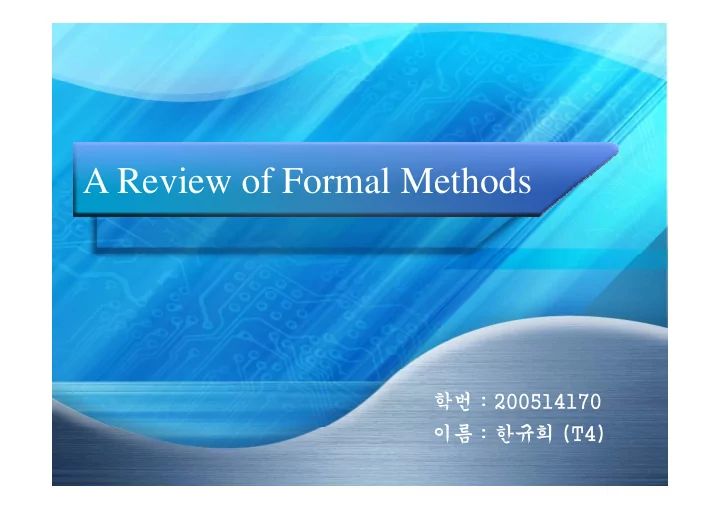

A Review of Formal Methods 학번 : 200514170 이름 이름 : 한규희 (T4) 한규희 (T4)
Contents • INTRODUCTION • INTRODUCTION • DEFINITION AND OVERVIEW OF FORMAL METHODS • SPECIFICATION METHODS • LIFE CYCLES AND TECHNOLOGIES • LIFE CYCLES AND TECHNOLOGIES WITH INTEGRATED FORMAL METHODS 1
Introduction • Certain precepts leads to better Programs. p p g • Design methodologies are varied • Underlying principles are the same d l i i i l h • Understand Core Ideas and the central Understand Core Ideas and the central Foundation • Core Ideas are invariant and Formal Methods C Id i i t d F l M th d define these 2
Definition and Overview • Support reasoning about formulae in some pp g language • Formal language • Formal language – set of strings over some set of strings over some well defined alphabet • Proofs – axioms � inference rules � Premises � consequents Premises � consequents • Properties can be proven. 3
Definition and Overview (Cont.) • A formal method in software development is a p method that provides a formal language for describing a software artifact (for instance describing a software artifact (for instance, specifications, designs, or source code) such that formal proofs are possible, in principle, th t f l f ibl i i i l about properties of the artifact so expressed. • Such methods are adaptations of the axiomatic method in mathematics method in mathematics 4
Definition and Overview (Cont.) • Use of Formal Methods • Record a system’s functionality (Z, Larch, Communicating Sequential Processes (CSP) etc ) Communicating Sequential Processes (CSP) etc..) • Specify aspects other than functionality (safety, security etc) security etc) • Fault tolerance, response time, efficiency, reliability etc can also be addressed. li bili l b dd d 5
Definition and Overview (Cont.) • Tools and Methodology gy • Proofs and programs should be developed in parallel parallel • Clearly understood constructions should be used • “Cleanroom approach” and heuristics may be used “Cl h” d h i i b d 6
Definition and Overview (Cont.) • Limitation • Requirements problem • Physical Implementation problems • Physical Implementation problems • Implementation Issues 7
Definition and Overview (Cont.) • Requirements problem q p • “You cannot go from the informal to the formal by formal means” formal means • Verification possible, not Validation. • Formal methods cannot replace the requirements F l h d l h i engineer with deep domain knowledge 9
Definition and Overview (Cont.) • Physical Implementation problems y p p • A physical machine is different from the abstract machine for which the program is made machine for which the program is made. • Proofs limited to a particular machine with limits and real characteristics and real characteristics • Compilers cause some problems • Bugs in memory, chips • Formal methods might never supplant testing g pp g 10
Definition and Overview (Cont.) • Implementation Issues p • Users’ intentions �� Formal Specifications • Physical implementation �� Abstract proofs • Physical implementation �� Abstract proofs • These gaps create inherent limitations • Scaling up to large scale projects is a problem S li l l j i bl 11
Specification Methods • Specification method says what a specification p y p must say • Language on the other hand determines in • Language on the other hand determines in detail how the concepts in a specification can be expressed • Different Methods Different Methods • Semantic Domains • Operational and Definitional Methods O ti l d D fi iti l M th d 12
Specification Methods (Cont.) • Semantic Domains • Exact rules state what objects satisfy a specification specification • Specification � set of formulae in a formal language language • Specification languages can be classified by their semantic domains i d i • ADT specification languages • Process specification languages • Programming languages 13
Definition and Overview (Cont.) • ADT specification languages p g g • used to specify algebras • ‘defines the formal properties of a data type • defines the formal properties of a data type without defining implementation issues • Process specification languages • Specify state sequences, streams, sequences, p y q , , q , partial orders and state machines • Programming languages • Programming languages 14
Definition and Overview (Cont.) • Model-Oriented Methods • Operational Model – Describes a system by providing a model providing a model • Functions from space of inputs to space of outputs • Property-Oriented Methods P t O i t d M th d • Definitional Models • Minimum set of conditions to be satisfied is the specifications • Algebraic (ADT) and axiomatic (preconditions and post conditions) models are the two classes. 15
Definition and Overview (Cont.) • Use of Specification Methods p • Customers should be provided English version, not formal version not formal version. • Details of project and skills of engineers to be considered considered • Operational models closer to programming practice i • Definitional model harder to construct and consistency and completeness are difficult to establish. 16
Life Cycles and Technologies • To get full advantages, Formal Methods should g g , be incorporated in standard • Two methods of integrating • Two methods of integrating • Heavy use of automated tools • Nonmechanical, nonautomated proofs • Division of verification tools Division of verification tools • Theorem proving tool • Model checking tool 17
Conclusions • Formal Methods provide p • More precise specifications • Better internal communication • Better internal communication • Ability to verify designs before execution testing • Higher quality and productivity • Should be incorporated as standard Should be incorporated as standard • Customized solutions may be required 18
Thank You k Y Th
Recommend
More recommend